The Challenge
SCWRD serves over 150,000 people in the Springfield, Illinois metro area, including the regional communities of Chatham, Grandview, Jerome, Leland Grove, Rochester, Sherman, and Southern View. Replacing their Spring Creek and Sugar Creek facilities became a priority for SCWRD, then known as the Springfield Metro Sanitation District (SMSD), due to the conditions of excessive service demand, increasingly strict environmental regulations, and aging equipment and operating systems—all of which were taxing the existing waste treatment infrastructure.Couple a growing community with new environmental laws. Then add to that the age of the plants. You reach what they call in our business, ‘the knee of the curve.’ Trying to spend money on an old facility becomes impractical. All of these factors together added up to the district finally making the hard decision to build two absolutely new facilities.
Growth
The district’s service area has expanded over the years, taking in the aforementioned neighboring communities adjacent the original Springfield metro service area. This radically increased service demand was taxing the existing plants. Measured as an annual average, the recommended flow capacity at the Spring Creek facility had exceeded its original limit of 20 million gallons per day (MGD) since 2004. While the Sugar Creek plant had not yet exceeded its original design flow capacity of 10 MGD taken as a yearly average, monthly average flow measurements often surpassed that recommended limit. It was clear that both plants were operating well in excess of their organic and solids design capacities. Environmental Regulations and Incentives
Environmental Regulations and Incentives
Environmental law is steadily evolving, and new incentives have been created since the plants were built and last renovated to meet mounting environmental challenges, such as reversing the hypoxic effects of the Gulf of Mexico’s “Dead Zone.” As part of this initiative, manufacturers along the Mississippi are being required to decrease their discharges. Meeting regulatory demands such as this requires new technology that didn’t exist when SCWRD’s Sugar Creek and Spring Creek plants were built and last renovated.Aging Infrastructure and Technology
Of SCWRD’s two plants, Sugar Creek is more modern; its construction was completed in 1973. Spring Creek, the original plant, was built in 1928. It was modified in the 1950s, 1970s, and again in the 1990s in costly attempts to maximize its efficiency and keep up with increasing service demand as well as environmental regulations.Partnering Early with a System Integrator
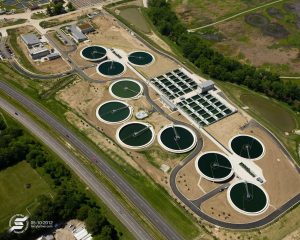
Spring Creek Plant
SCADAware’s System Delivery
SCADAware’s role in the project was to deliver the complete SCADA system. Initially, SCADAware provided preliminary engineering assistance to CMT in preparation for the bid and construction documents. After the bid, SCADAware’s involvement with the project included SCADA system design engineering, implementation, in-house testing, onsite startup, documentation, and closeout/training. SCADAware was also tasked with meeting all of the panel design and fabrication demands of the new plant.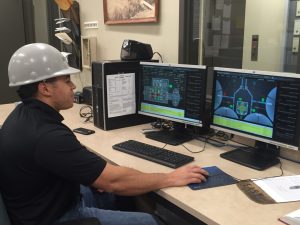
SCADAware Senior Electrical Engineer, Josh Niemi, P.E.
SCADA System Specifications
This building plan view, depicting the plant influent in the Headworks building (Figure 1), consists of three screen channels, a bypass channel, and two grit chambers. With Lead/Lag operation, one screen channel is always operating, and additional channels are opened and called to operate based on influent level.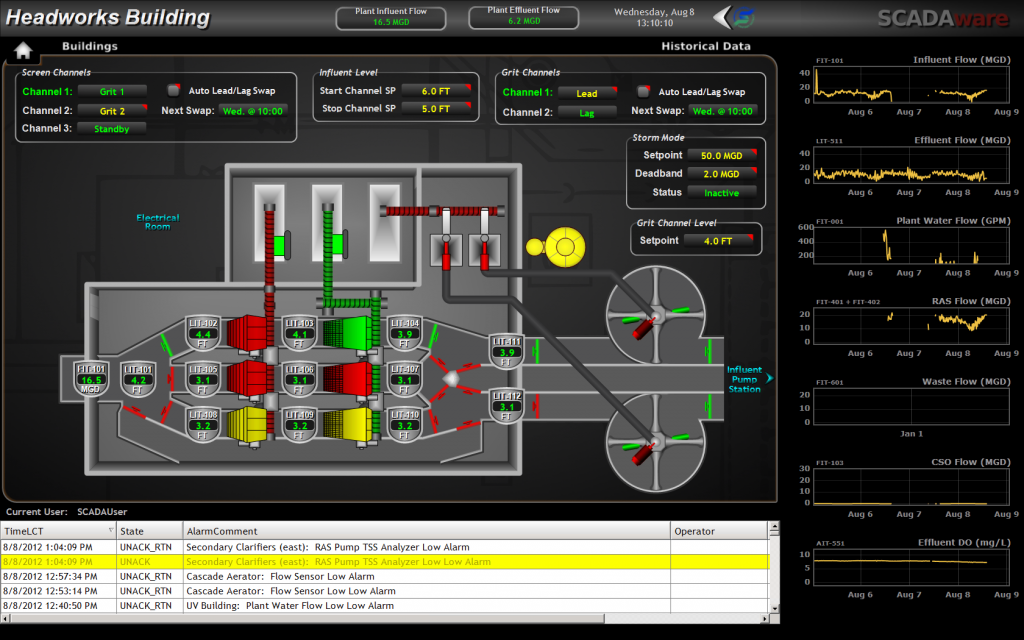
Figure 1 — Headworks Plan View

Figure 2 — Grinder Motor Control Window
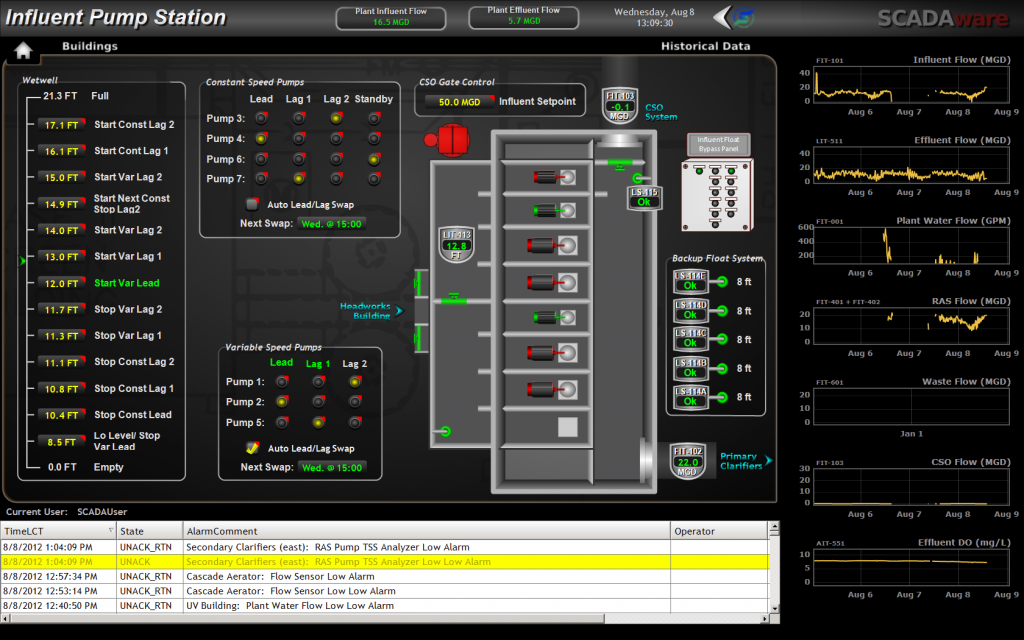
Figure 3 — Influent Pump Station Plan View
SCADA at Spring Creek
The SCADA system at SCWRD’s Spring Creek facility primarily controls process equipment, monitors OEM equipment and processes, records process data, and provides alarming for fault conditions. Alarms are categorized by severity, which gives the system the flexibility to self-correct for out-of-bounds process conditions before escalating to an after-hours alarm call. The system annunciates alarm conditions through the SCADA screens and also provides telephone alarms through a software alarm dialer that functions during times when the plant is operating unmanned. The Spring Creek plant’s SCADA system monitors approximately 20,000 data points, including information from the Remote Terminal Units (RTUs) at SCWRD’s 32 lift stations and 50+ PLCs. System users include plant operators and supervisory personnel. Operators interface with the SCADA system through the main operator station in the control room and can also control the system through industrial PC panels in process buildings.SCADAware was an invaluable part of our team in optimizing operational performance with automation technology at our new plant. From an operational standpoint, our challenge in building a new facility that would double our capacity was to find a way to get it done without simply doubling everything—labor, energy cost, etc. We needed to build a smarter plant. SCADAware’s expertise in SCADA systems and integrating many different types of technologies exceeded our expectations of what we could accomplish.
Empowering Operators
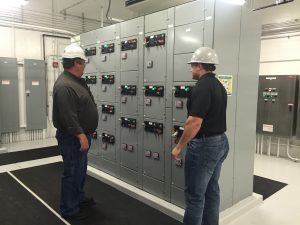
MCC Room
Before the SCADA system, if there were problems, you would not have the information on how bad [a] problem was or where [a] problem was, so you had to overcompensate—not only with equipment. You also had to overcompensate with manpower. Having this information at [our] fingertips with the SCADA system, our operators are high-performance operators able to make informed judgment calls based on real-time, accurate information.
Efficient Reporting
The SCADA system has simplified reporting—to the US EPA, Illinois EPA, as well as trustees—for SCWRD. At the Spring Creek plant, these reports are automatically generated each month by the SCADA system. Additionally, a flow report summarizing daily key flows can be generated on demand and used for EPA reporting. All process meters (ex. flow, level, pressure) are programmed with a standard minimum/maximum/average statistics function via the PLCs. The PLCs also track total flow for flowmeters and total usage for chemical tote scales. Generated statistics for any meter are easily resettable. Typically, an operator will record daily flows at the SCADA workstation and then simply click a button on each flow meter popup window to reset each one. The process of recording daily flows for each flow meter takes about 15 minutes. Previously, it could take as long as two hours for an operator to physically walk the plant to gather and record the same data.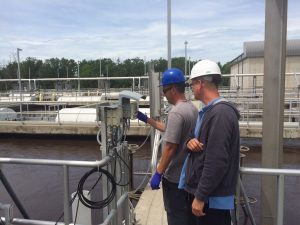 The dissolved oxygen (DO) concentration of a water treatment facility’s discharge drastically affects the health of the receiving stream—in this case, the Sangamon River. The State of Illinois requires SCWRD to conduct a daily test to determine whether the DO level of the flow directed to the receiving stream is within acceptable parameters. Thanks to the advances in instrumentation and programming implemented during the rebuild, the DO level of the Spring Creek facility’s receiving stream is monitored in real-time and recorded to a reporting database once per minute. This attentive monitoring protects the Sangamon River and works to ensure its long-term environmental health. In the past, Spring Creek plant operators relied on analysis reports of samples to make judgment calls on possible changes in certain plant processes. Such a procedure, from taking the sample to being handed the results of its analysis, could take hours—and this was often the only data immediately available to an operator when considering a given course of action. The SCADA system has greatly reduced labor hours previously allotted to manual analyses of plant processes by SCWRD staff and has greatly increased the spectrum of data on demand. Online instrumentation reports to the SCADA system, giving SCWRD real-time data pertaining to plant processes. Timely reports on solids levels and solids concentration, for example, are easily generated.
The dissolved oxygen (DO) concentration of a water treatment facility’s discharge drastically affects the health of the receiving stream—in this case, the Sangamon River. The State of Illinois requires SCWRD to conduct a daily test to determine whether the DO level of the flow directed to the receiving stream is within acceptable parameters. Thanks to the advances in instrumentation and programming implemented during the rebuild, the DO level of the Spring Creek facility’s receiving stream is monitored in real-time and recorded to a reporting database once per minute. This attentive monitoring protects the Sangamon River and works to ensure its long-term environmental health. In the past, Spring Creek plant operators relied on analysis reports of samples to make judgment calls on possible changes in certain plant processes. Such a procedure, from taking the sample to being handed the results of its analysis, could take hours—and this was often the only data immediately available to an operator when considering a given course of action. The SCADA system has greatly reduced labor hours previously allotted to manual analyses of plant processes by SCWRD staff and has greatly increased the spectrum of data on demand. Online instrumentation reports to the SCADA system, giving SCWRD real-time data pertaining to plant processes. Timely reports on solids levels and solids concentration, for example, are easily generated.